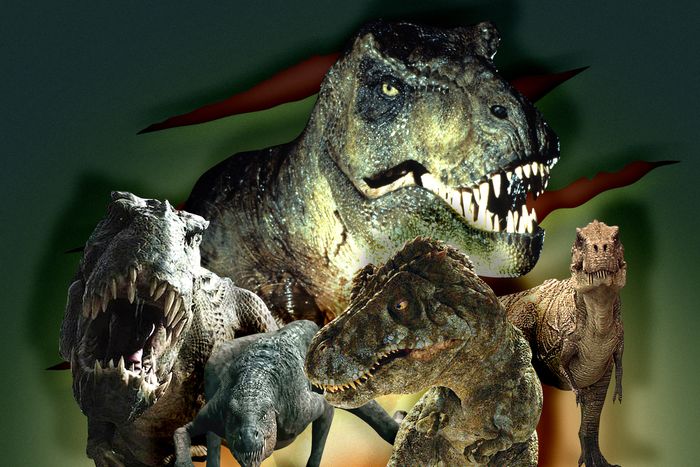
When most modern moviegoers think of dinosaurs on the big screen, they tend to conjure a few key images: A tyrannosaurus pacing out of a tropical thunderstorm, head swiveling like a bird to track carloads of fleeing, screaming humans; a brachiosaur rearing, its long neck plucking at the canopy of a tree; two scaly, evil-eyed velociraptors sneaking into an industrial kitchen, barking and squabbling. Jurassic Park — Steven Spielberg’s 1993 adaptation of Michael Crichton’s blockbuster novel — reshaped cinema’s idea of dinosaurs. Gone were the ponderous, tail-dragging movie monsters of yesteryear. Now they could be agile, cunning, and animalistic, closer to the scientific consensus of what these animals actually looked like and how they behaved.
But ever since Jurassic Park, dinosaurs on the big screen have stayed frozen in time. In 2023, they are just as likely to be cut-and-pasted from Spielberg’s film as they were in the ’90s and 2000s: This year’s Sam Raimi–produced, Adam Driver–starring 65 featured scaly, evil-eyed raptors and a toothy, reptilian tyrannosaur that looms out of the pounding rain. Anyone who’s paid even cursory attention to paleontology over the past decade can tell you that this probably isn’t what dinosaurs looked like. Feathered dinosaurs were discovered in 1998, and in the time since, paleontologists have unearthed a wealth of new species and information.
It might be easy to dismiss questions of paleontological accuracy as specialist griping. But one reason the dinosaurs of Jurassic Park made such an impact on regular moviegoers, too, is because they were so visually novel and, yes, rigorous: Look, the film told you. This is a real dinosaur. They may not be note-perfect, but they’re convincing and compelling, hitting with the force of revelation. Now, increasingly in movies — including some of Jurassic Park’s own grand-sequels — these animals feel like placeholders. There’s no mystery left: If you’ve seen one cinematic dinosaur, you’ve seen them all.
Dinosaurs have been a staple at the movies since there were movies. In 1914, the charming, long-necked Gertie was the star of one the first animated short films. Dinosaurs went on to make starring appearances in films by stop-motion animation pioneer Willis O’Brien (the effects wizard behind 1925’s The Lost World and the 1933 King Kong) and his protégé, Ray Harryhausen (who worked on 1966’s Raquel Welch–starring One Million Years BC and 1969’s The Valley of Gwangi), among many others. They were brought to life through claymation or rubber suits, and characterized according to how scientists understood dinosaurs at the time: as dim-witted reptilian hulks, only as fast as they needed to be to be cinematically threatening.
By the 1980s, however, the scientific paradigm had shifted. Scientists learned that dinosaurs were likely warm-blooded, active, and behaviorally complex. This new research attracted the interest of techno-thriller writer Michael Crichton, who started work on the novel that would become Jurassic Park. Even before it was published, remembers concept artist Mark “Crash” McCreery, a copy was being passed around the Stan Winston Studio, a special effects house focusing on animatronics and practical effects for films like Terminator, Predator, and Aliens.
The book was on the fast track for a Spielberg adaptation, and McCreery was one of the people tasked with figuring out what the film’s dinosaurs should look like. His team devoured all the cutting-edge paleoart and technical references it could, and paleontologists like Robert Bakker and John Horner consulted on the designs that McCreery produced. Their goal was to produce dinosaurs that felt lifelike and in keeping with the emerging popular consensus, while still angling for drama and avoiding the feeling of a “science project.” The team took creative liberties, too, of course, including adding an expanding, rattling frill for the crested predator dilophosaurus, which devours a hapless Wayne Knight. “Anything that helped with the mystery and awe of what dinosaurs could be, we latched onto,” McCreery recalls.
Some of the team’s ideas — based on what was then scientific guesswork — were a bit too radical for Spielberg, he remembers. “We were kind of pushing for feathers on the raptors a little bit, and he was like, ‘No, no, no. No feathers. Not yet.’”
Still, the rigor that went into McCreery’s concept work for Jurassic Park and its less-beloved sequels, The Lost World and Jurassic Park 3, ensured that the films’ designs have aged fairly well, says Steve Brusatte, a dinosaur specialist with the University of Edinburgh who consulted on the latest film in the franchise, Jurassic World: Dominion. Perhaps the long-necked sauropods are a bit too lumbering and elephant-like. The raptors are too big, and the frilled dilophosaurus is too small; all of the predatory dinosaurs have wrists that are bent the wrong way — palms down instead of parallel. (Dinosaurs were clappers, not slappers, as the paleo-people say.) “But I don’t think you can seriously fault any of those designs,” Brusatte said. “Those are minor details that, to me, don’t matter in the grand scheme of things.”
Jurassic Park threaded an exceedingly tricky needle: portraying dinosaurs as both captivating movie monsters and plausible, awe-inspiring animals. McCreery and his colleagues’ work also ended up becoming the template for decades of subsequent dinosaur films. (And commercials — he recalls watching television once and thinking, Oh, that’s our raptor.) “That, to them, is what a classic dinosaur looks like,” McCreery said. “For contemporary audiences, as time goes by, that becomes the standard.”
Among the ranks of cheap, micro-budget fare, Jurassic copies are sometimes astoundingly blatant in their pilfering of McCreery’s design work: consider projects like Extinction (2014); Cowboys vs. Dinosaurs (2015); Jurassic Predator (2018); and Jurassic Hunt (2021). Bigger films have been light-fingered as well: The sci-fi comedy reboot Land of the Lost (2009) put some work into differentiating its T. rex, but it lifted its raptors right out of Isla Nublar. Even blockbusters that have tried to differentiate themselves — like Peter Jackson’s 2005 remake of King Kong — have often done so by blending retro dinosaur looks with the active, swift menace seen in Jurassic Park. Meanwhile, Brusatte noted, the few cinematic attempts to present more up-to-date animals, like Disney’s Dinosaur (2000) and Walking With Dinosaurs (2013), both of which he consulted on, didn’t exactly set the world on fire.
By the time Universal revived the Jurassic Park franchise in 2015, the scientific consensus on dinosaurs had again advanced. By that point, feathers were no longer simply a reasonable guess, as they’d been in 1993: Decades of new discoveries had solidified their presence in many families of dinosaurs, from simple fur-like coats to quills and wings. In 2015, Brusatte co-authored a scientific paper announcing a new Chinese dromaeosaur — the family to which the velociraptor belongs — with an elaborate coat and wing feathers. “The reality is probably all dinosaurs had some type of feather, and the dinosaur ancestor probably had feathers, the same way all mammals have some type of hair,” he tells me. Likewise, unexpected discoveries like the rooster-like comb on a duck-billed dinosaur called edmontosaurus were helping drive a shift toward a picture of dinosaurs with a wider variety of colors, builds, and display organs, producing animals that looked meatier, stranger, and more experimental.
Jurassic World and its immediate sequel made no particular effort to keep up. At the time, dinosaur fans noted that the films’ animals looked like many-Xeroxed copies of McCreery’s work — less meticulous, more cartoonish. (Many said the same about the new films themselves.) The reasoning given, in-film, was that the dinosaurs weren’t real animals, but genetically engineered monsters. But Brusatte has another theory: “They’re not straying from that design — that’s like Coca-Cola changing their logo or something. It’s just not going to happen.”
For a series of films ostensibly about the dangers of attempting to render real animals into merchandise, this has a certain bitter irony. And in continually casting back to the iconography of Spielberg’s film, the overwhelming impression across the last three decades of copycats is a lack of imagination, says science journalist Riley Black, who’s written extensively about dinosaurs for Smithsonian and National Geographic. What made Jurassic Park and its immediate successors special — the attempt to blend scientific rigor, mystery and thrills — got lost in a parade of conservative imitations. “Dinosaurs are such stock monsters again at this point that you can just plonk one down into a movie and you don’t have to think about it,” she said. “It’s not thinking about them as animals. It’s thinking, We need something big with a lot of teeth.”
It’s all the more galling when current paleontological research offers so many opportunities to imagine dinosaurs that are stranger, more outlandish, and — if need be — more frightening. Under Brusatte’s consultancy, Dominion did add a handful of feathered species: a short scene with a new, feathered dromaeosaur, as well as the tiny, feathered tyrannosaur moros and the immense, scythe-clawed herbivore therezinosaurus. But he still thinks “the feather thing is underdone. Just because there are a few dinosaurs with feathers in one blockbuster film doesn’t mean that concept has really percolated into public consciousness.” Big-budget movies might not have a monopoly on mass-market dinosaurs, but they represent what studios think audiences want, and influence the way non-experts envision extinct animals. The result is a dinosaur-and-egg conundrum: As those films are stuck in the scientific past, the popular image of them is as well — leading other studios to continue to keep their dinosaurs featherless.
But feathers are, in some sense, the least of it. There were dinosaurs like miniature ant-eaters, enormous crocodilian herons, tiny spiked dragons, the combination of a goose and a sloth. The great necks of long-necked dinosaurs could have been billboards, full of inflatable sacs, while other dinosaurs might have been as extravagant and garish as their modern relatives. Dinosaurs we think of as peaceful herbivores could have been aggressive and bad-tempered; dinosaurs like tyrannosaurus changed so much over their lifespan they’ve been mistaken for different species. Animals today — even familiar ones — can surprise us with bizarre behaviors, like lamb-killing armadillos and tree-climbing crocodiles. Why not forge beyond the stock image of the roaring monster? Why not allow dinosaurs the courtesy of being weird?
“You look at dinosaur art as an example of where thinking is going, and it’s this amazing world,” McCreery said. There’s an increasing willingness to explore the modern view or push it forward, whether in visual art, in survival- or park-building videogames, or in television shows like the tremendously successful Apple TV+ documentary Prehistoric Planet. “It’s not so much about what’s the design de jour of dinosaurs, it’s about looking at them in a direction of exploration and pushing those boundaries of what’s possible.”
It’s been 30 years, in other words. Maybe it’s time to try and leave the park.




